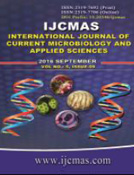


 National Academy of Agricultural Sciences (NAAS)
National Academy of Agricultural Sciences (NAAS)

|
PRINT ISSN : 2319-7692
Online ISSN : 2319-7706 Issues : 12 per year Publisher : Excellent Publishers Email : editorijcmas@gmail.com / submit@ijcmas.com Editor-in-chief: Dr.M.Prakash Index Copernicus ICV 2018: 95.39 NAAS RATING 2020: 5.38 |
Catheter associated urinary tract infections (CAUTI) are one of the most common cause of hospital acquired infections or nosocomial infections. Indwelling urinary catheterization in hospital setting has become a potential source for drug resistance and has now gained a prime importance in patient outcome. Hence, the aim of this study is to isolate uropathogens from CAUTI and find out antimicrobial sensitivity pattern among the isolates. This study was conducted over a duration of 2 years and urine samples were collected from 126 catheterized patients. The urine samples were processed microbiologically and antimicrobial sensitivity was performed. Out of 126 catheterized patients, 26 developed CAUTI and Escherichia coli 17 (65.3%) was the most common organism followed by Proteus species 4 (15.38%), Klebsiella pneumoniae 2 (7.6%), Enterococcus species 2 (7.6%) and staphylococcus epidermidis 1 (3.8%). Enterobacteriaceae showed significant resistance to drugs like gentamycin, ciprofloxacin, and ceftazidime and were highly sensitive to drugs like imipenem, meropenem, nitrofurantoin, amikacin, ceftazidime - clavulinic acid and piperacillin - tazobactum. Among the gram positives, enterococcus 2 (7.6%) was the most common organism followed by staphylococcus epidermidis 1 (3.8%). Only one (3.8%) ESBL producer was detected among gram negative bacilli. 26 patients (20.63%) developed CAUTI among the analyzed 126 patients. Among these 13 (50%) developed CAUTI on 7th day of catheterization. Hence, dedicated infection control practice along with early diagnosis and timely therapeutic management is very important to control these CAUTI.
 |
 |
 |
 |
 |